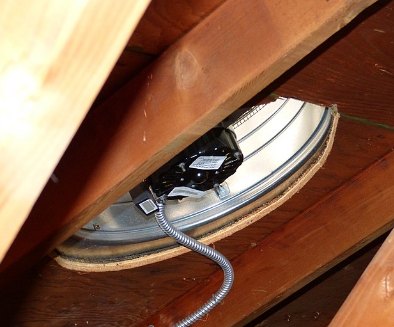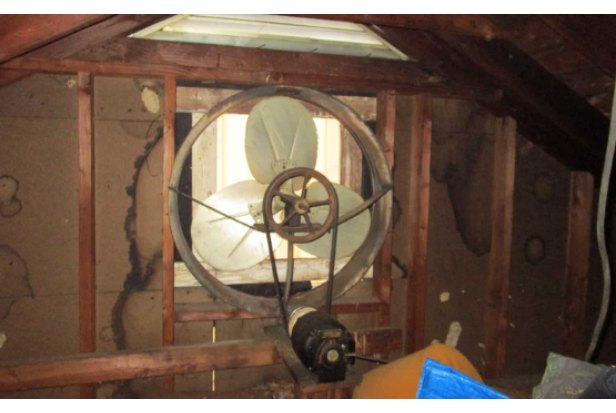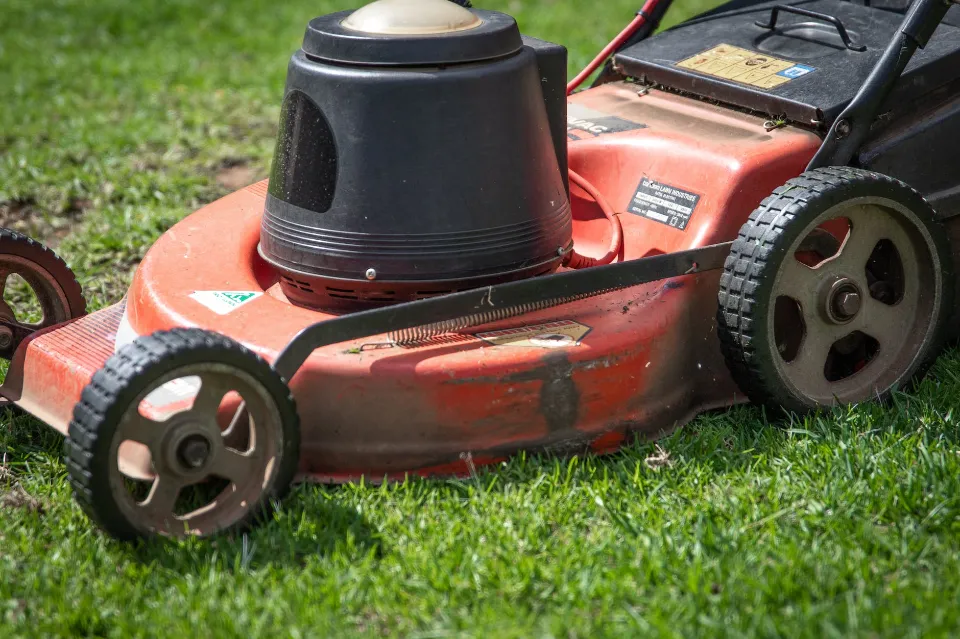Every room in your home can become more comfortable by improving the air circulation, and it can also help you save money on energy costs. Selecting the option that best meets your needs is important if you’re thinking about installing a whole house fan or an attic fan to get more use out of your current HVAC system. You must be aware of the following.
What is a Whole House Fan?
Whole house fans are powered fans with a typical diameter of 24 to 36 inches that can be used to ventilate an entire home, including the attic.
Instead of using the HVAC system, whole-house fans are used to cool entire homes. Instead of using a traditional air conditioner, a whole-house fan can cool a home for up to 80%–90% less money.
Many users also enjoy the breeze effect that a whole house fan can provide, and it gives a nice airy feeling to the home’s interior.
Pros
- less expensive to cool the house than with conventional HVAC systems.
- Gives a nice airy feeling on the inside known as the breeze effect.
- Much more quickly than a typical air conditioner, whole-house fans can cool the house.
- More affordable than air conditioning systems are whole-house fans.
- They are occasionally employed to remove hot air from the house just before the air conditioner kicks on.
Cons
- Some whole-house fans, especially older, more conventional models, can be noisy.
- Only in drier, cooler climates do they perform at their best. In hot and humid regions of the nation, they don’t function well.
- Whole house fans are almost useless if it is very hot outside
- To function properly, whole-house fans require a minimum of 1 sf of attic venting for every 750 cfm.
- Winter air infiltration is caused by whole-house fans. When not in use, the appliance should be covered by an insulated box.
What is An Attic Fan?
her installed on the roof or gable wall and used to ventilate only the attic. These specialized fans have thermostats so when the attic’s temperature reaches around 95ºF, it will automatically turn on.
During warm weather, attic fans are primarily used to exhaust hot air in order to cool down the attic and roof shingles. Since less heat radiates downward into the house, a cooler attic is also beneficial to the A/C system.
In colder months, attic fans can also be used to help stop condensation, ice damming, and mold growth.
Pros
- Helps the A/C system by cooling down the attic (less heat radiates into home)
- Ventilates the attic during cold weather to reduce moisture and mold growth
- Extends the life of asphalt shingles by reducing the roof temperature
- Can be easier to install than an entire soffit & ridge passive vent system
Cons
- The intrusion of water may originate from attic fans.
- For every 300 cfm, attic fans require a minimum of 1 sf of intake openings.
- Conditioned air can be sucked from the house’s interior if the attic doesn’t have enough makeup air.
- There are solar-powered attic fans, but they require electricity to operate.
How Do Whole House Fans Work for Cooling?
house fans are only used when the outdoor air is cooler than inside of the home.
This is especially true when the sun sets, the temperature outside drops, but the inside of the house is still very warm.
Many people love whole house fans because when the sun goes down, they only have to run the whole house fan for 15-30 minutes and the home will be cool for the rest of the night. According to Kansas State University, dry climates and times when there are significant differences in temperature between day and night are the best conditions for whole-house fans to operate.
What is the Whole House Fan Breeze Effect?
The breeze effect created by whole-house fans is utterly adored by some homeowners. At this point, rather than just for cooling, the whole-house fan is used to create a breezy atmosphere inside.
Everywhere in the house, it causes an uncomfortable sensation that is similar to having a low-speed desk fan on your skin.
How Do Attic Fans Work for Cooling?
Attic fans can assist a standard air conditioner in cooling the house. In warm weather, if the attic becomes warm, heat will radiate from the attic and into the house, particularly the top level.
This simply makes it more difficult for your air conditioner to reduce the indoor temperature. Your home will feel less comfortable as a result of the A/C using more energy and running more frequently.
The most uncomfortable homes, in my experience as a home inspector, are those with significant temperature differences, like a hot upper level. The attics of these houses are typically not well ventilated.
How Do Attic Fans Prevent Ice Damming?
Lack of ventilation in the attic and the melting of the snow by hot air from the house cause an ice dam at the eave of the roof.
A phenomenon known as ice damming, which can seriously harm a home, can occur during the cold season if warm air from the interior of the house enters your attic. In essence, when it’s cold outside, your attic gets too hot and melts the roof’s snow.
This melted snow refreezes and forms a kind of ice dam when it gets too close to the edge of the roof. More water is held back by this ice dam, which increases the risk of water infiltration and roof damage.
Do Attic Fans Prevent Mold Growth?
As a result of inadequate ventilation and excessive moisture, mold is growing on the roof trusses in the attic.
Mold growth can be dangerous and expensive if there is too much moisture in the attic. When two air masses of different temperatures collide, moisture mostly results. When the attic is cold but the interior of the house is hot, for instance, or when the attic is hot but the house is cold.
Moisture may develop on the roof sheathing, framing, and paper-faced insulation when these two air temperatures collide in the attic.
A food source, moisture, and darkness are the only conditions needed for mold to grow. If there is too much moisture in the attic, mold will have everything it needs to grow.
Can Attic Fans Protect Asphalt Shingles?
Attic fans can help preserve and protect asphalt roof shingles, which is a frequently ignored advantage. If they become too hot, asphalt shingles will deteriorate too soon.
When the attic becomes extremely warm, the sun’s rays quickly warm up the shingles, and this heat is then transferred to the roof sheathing and wood rafters. Similar to how your car warms up when the windows are rolled up when parked, this heat transfers to the attic air and creates a type of heat trap.
How Are Whole House Fans and Attic Fans Controlled?
Due to the need for 2-3 windows to be open in order for whole house fans to function, homeowners must manually turn them on using a wall switch (or phone app).
Using a thermostat or any other type of scheduled activation of whole-house fans is not something we advise.
According to the U.S., if a whole-house fan is activated while only a few windows (or doors) are open, it will result in air pressure issues in the house like backdrafting. Department of Energy.
In contrast, thermostats are almost always used to control attic fans, which are activated when the outside temperature reaches 95°F. However, attic fans can also be manually turned on using a wall switch or even a smartphone app.
What Are the Risks of Whole House Fans and Attic Fans?
There are some dangers when homeowners choose to install attic and whole house fans.
- Sucking Air From The Home Interior
Having sufficient venting or makeup air in the attic, as described at EnergyStar.gov, is crucial when installing whole house fans and attic fans. If the attic does not have enough open venting, a whole-house or attic fan will draw conditioned air from the house’s interior when used. The price of the A/C system would go up as a result.
Before installing one of these appliances, homeowners should verify that there is enough venting and also that the current soffit, ridge, or gable vents aren’t blocked by debris or insulation.
Additionally, air sealing all recessed lights, bathroom fans, and other ceiling penetrations is crucial, as is having an attic with over 10 inches of insulation.
- Carbon Monoxide Hazards
Backdrafting could become dangerous if you install an overly powerful attic fan or whole house fan along with gas-burning appliances.
When gas byproducts are drawn into the house as opposed to venting outside, backdrafting occurs. If you have gas appliances like a dryer or water heater, you should never use whole-house fans.
- Declining Use
Attic fans or whole-house fans are extremely uncommon in newly constructed, modern homes.
Since a properly insulated, air-sealed, and ventilated attic won’t require powered attic fans or whole house fans, the majority of home professionals (including home inspectors) don’t recommend these appliances.
A whole house fan or attic fan, however, might be a great option for your home if it’s older and in the appropriate climate.
- Air And Water Leaks
Water intrusion is frequently caused by attic fans. Basically, plumbing vents, skylights, attic fans, and other holes in the roof could all lead to water leaks.
In the winter, whole-house fans can also cause interior air leaks. Since hot air rises, using a whole-house fan in the winter is equivalent to opening a window in your house. In order to protect them from the winter weather, whole house fans must have an insulated box installed over them.
Insulated dampers on some whole-house fans close automatically when not in use.
- Attic Fans Creating Venting Conflicts
In some cases, installing passive vents or attic fans too close together can lead to ventilation conflicts, which in turn can lead to hot spots.
If two attic fans are installed close to one another, one attic fan will draw air from the other attic fan, disrupting any ventilation gains.
Alternatively, if an attic fan is placed near a ridge vent, it will draw air in from the ridge while obstructing airflow from the eaves or soffits, causing hot spots at the bottom of the attic.
- Vermiculite Or Other Toxic Substances Can Be Pulled Into Home
The United States no longer makes use of vermiculite, a type of insulation that contains asbestos., but some homes still have it.
Asbestos or other toxins may enter the home if the attic air is forced back into the interior by the whole-house fan or attic fan.
Where Do Whole House Fans and Attic Fans Work Best?
Certain geographical and climatic conditions favor the use of attic and whole-house fans.
Cooler, drier climates are best for using whole-house fans.
In hot climates, attic fans are best for cooling, and in cold climates, they are best for preventing moisture buildup and mold growth.
What is Better An Attic Fan Or Whole House Fan?
A whole house fan and an attic fan serve very different functions, so it is impossible to say which is superior.
An attic fan is made to run during the hottest part of the day in order to keep the attic cool and thereby indirectly assist the home’s HVAC system.
A whole house fan is made to be used mostly in the morning and early evening, when the outside air is cooler. Whole house fans are used to totally replace a traditional air conditioning system when conditions are right.

What Are the Negatives of a Whole House Fan?
The limitation of whole-house fans to operation when the outside temperature is lower than the indoor temperature is a drawback.
Whole house fans can be noisy at times (depending on the model) and can cause air leaks if they aren’t covered and insulated during the winter.
Are Attic Fans and Whole House Fans the Same Thing?
Despite the fact that attic fans and whole house fans are occasionally used interchangeably, they are two entirely different appliances.
With the sole purpose of ventilating the attic, attic fans are mounted on the roof or gable wall.
Fans that circulate air throughout the entire house are mounted on the ceiling of the topmost level of the building.
What Are the Different Types of Whole House Fans and Attic Fans?
Ducted whole-house fans and ductless whole-house fans are the two primary varieties.
Ducted whole house fans have a duct that extends from the appliance to the outside, reducing noise and boosting efficiency.
Attic fans come in two main varieties: gable attic fans and roof-mounted attic fans. In the southern regions with plenty of sunshine, solar-powered attic fans are also common.
Final Thoughts on Whole House Fans Vs. Attic Fans
Although they are actually separate appliances, whole-house fans are occasionally referred to as “attic fans.”
When it’s hot outside, attic fans come on and may even run concurrently with your air conditioning unit. Wintertime attic ventilation can help prevent ice damming and reduce moisture.
Only in the early morning or late evening, when it is cooler outside than inside, are whole-house fans turned on. You can cool and ventilate your entire home without using the air conditioning by using whole-house fans.
FAQs
Whole House Fans Good Or Bad
A whole-house fan can improve the comfort level inside your home by drawing cooler air in from the outside and pushing warmer air out through the attic. Running a whole-house fan can also help you save money on energyby minimizing the amount of time you spend using the air conditioner.
How Does a Whole House Fan Work
The whole house fan pulls air in from open windows and exhausts it through the attic and roof. Along with whole-house cooling, it offers good attic ventilation. 15 to 23 air changes per hour (which varies depending on the climate, the layout of the home, etc.) should be provided by whole-house fans.








